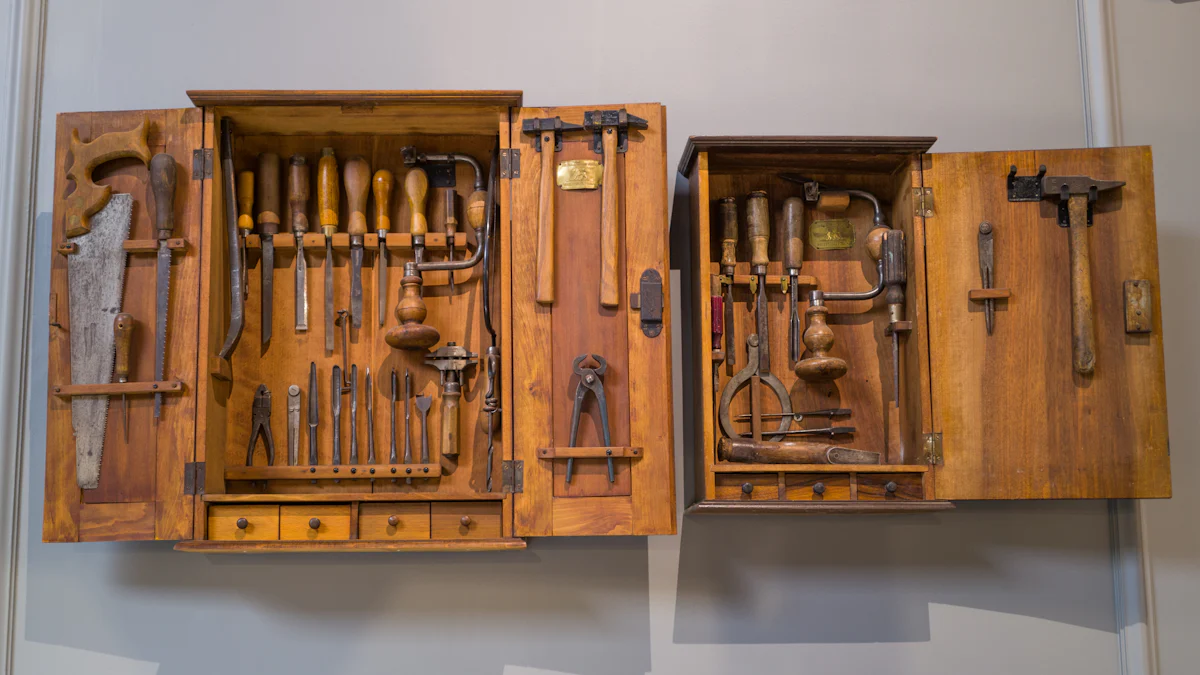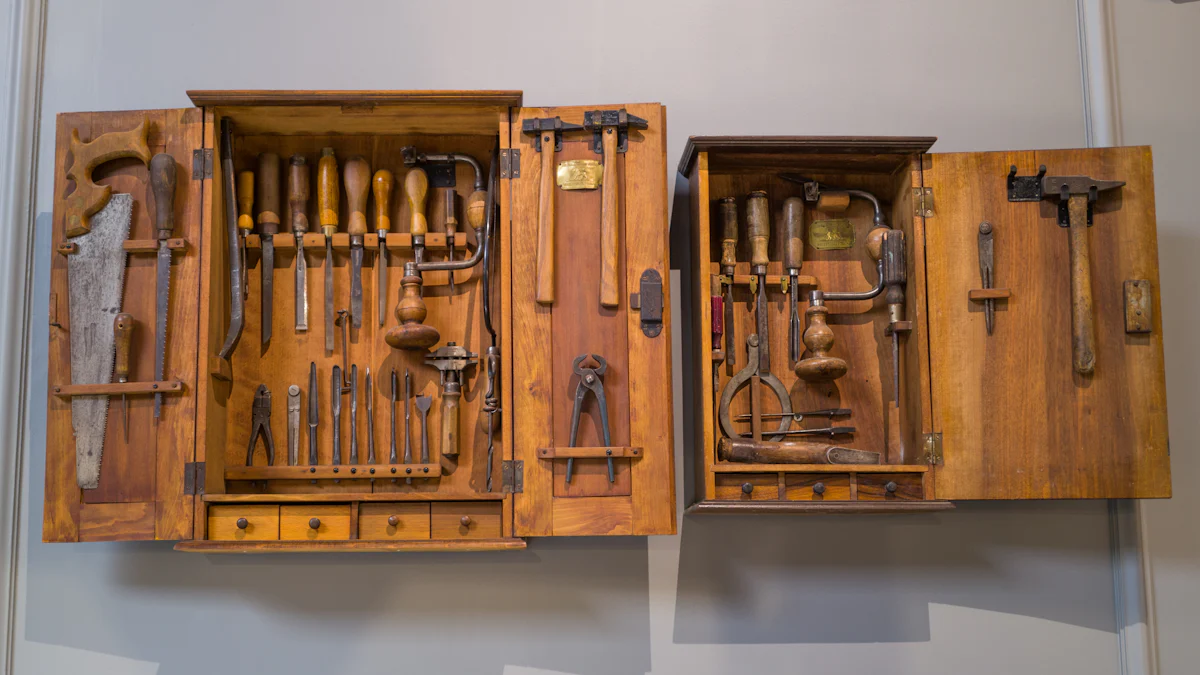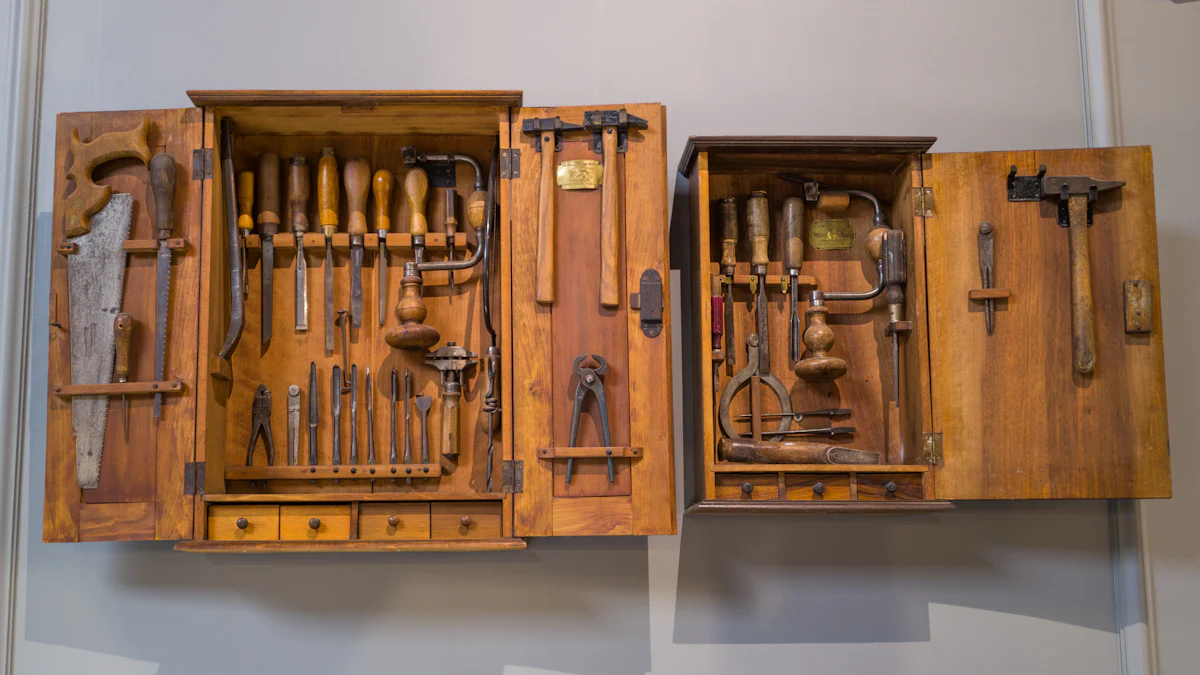
Antique woodworking tools captivate collectors and woodworkers alike. The exceptional craftsmanship, historical significance, and rarity of these tools contribute to their allure. Understanding the value of old hand tools is crucial for both enthusiasts and investors. This blog will explore the top 20 most valuable antique woodworking tools, shedding light on their unique attributes and market worth.
Historical Context of Woodworking Tools

Evolution of Woodworking Tools
Early Tools and Their Development
Ancient civilizations like the Egyptians, Greeks, Romans, and Chinese utilized woodworking tools. These early tools included simple hand planes, chisels, and saws. The Egyptians crafted intricate furniture and structures using these basic tools. Greeks and Romans advanced woodworking techniques, creating more sophisticated designs and tools. The Chinese developed unique woodworking methods, contributing to the global evolution of these tools.
Medieval times saw further advancements in woodworking tools. Blacksmiths and craftsmen improved the design and functionality of hand tools. This period marked the introduction of more specialized tools, enhancing the precision and efficiency of woodworking.
Industrial Revolution and Its Impact
The Industrial Revolution brought significant changes to woodworking tools. Mechanization transformed tool production, making tools more accessible and affordable. Factories began mass-producing tools, leading to standardized designs and improved quality. Innovations such as steam-powered machinery revolutionized woodworking, allowing for greater productivity and consistency.
The Industrial Revolution also introduced new materials and technologies. Steel replaced iron in many tools, enhancing durability and performance. These advancements increased the value of old hand tools from this era, as collectors and woodworkers sought high-quality, historically significant items.
Significance of Antique Tools in Modern Times
Collectors’ Interest
Antique woodworking tools hold great appeal for collectors. The craftsmanship and historical significance of these tools make them highly sought after. Collectors appreciate the unique attributes and stories behind each tool. The value of old hand tools often reflects their rarity and condition, with well-preserved items fetching higher prices.
Collectors often seek tools from renowned makers or those with distinctive features. Tools with original markings or patents can command premium prices. The historical context of these tools adds to their allure, making them prized possessions for enthusiasts.
Historical Value
Antique woodworking tools offer valuable insights into historical woodworking practices. These tools reflect the technological advancements and craftsmanship of their time. Museums and historians study these tools to understand the evolution of woodworking techniques and materials.
The value of old hand tools extends beyond monetary worth. These tools serve as tangible connections to the past, preserving the legacy of skilled craftsmen. The historical significance of these tools makes them important cultural artifacts, worthy of preservation and study.
Categorization of Antique Woodworking Tools

Hand Planes
Types of Hand Planes
Hand planes serve as essential tools in woodworking. These tools smooth wood surfaces and shape them with precision. The primary types include bench planes, block planes, and specialty planes. Bench planes come in various sizes, such as jack planes and jointer planes. Block planes offer versatility for smaller tasks. Specialty planes include molding planes and rabbet planes, each designed for specific functions.
Notable Examples
Several hand planes stand out due to their historical significance and craftsmanship. The Stanley No. 1 Bench Plane remains highly sought after by collectors. This plane features a compact design and exceptional build quality. The Norris A5 Smoothing Plane represents British craftsmanship at its finest. Collectors prize this plane for its adjustable mouth and fine steel blade. The Tidey Patent Beveling Plane showcases innovation with its unique beveling mechanism. These examples highlight the value of old hand tools in the market.
Saws
Types of Saws
Saws play a crucial role in woodworking, offering various types for different tasks. Hand saws include rip saws and crosscut saws, each designed for specific cuts. Back saws feature reinforced spines for precise work, such as dovetail saws and tenon saws. Frame saws use tensioned blades for intricate cuts, including bow saws and coping saws.
Notable Examples
Certain saws hold significant value due to their rarity and craftsmanship. The Disston D-8 Hand Saw remains a favorite among collectors. This saw features a comfortable handle and high-quality steel blade. The Atkins No. 400 Back Saw stands out for its precision and durability. The Sandvik Bow Saw showcases Swedish engineering with its robust frame and sharp blade. These notable examples underscore the value of old hand tools in woodworking.
Chisels
Types of Chisels
Chisels offer versatility in woodworking, with various types for different applications. Bench chisels serve general-purpose needs, while paring chisels provide precision for delicate work. Mortise chisels feature thicker blades for cutting mortises. Carving chisels come in various shapes, such as gouges and V-tools, for intricate designs.
Notable Examples
Several chisels stand out for their historical and practical value. The Stanley 750 Series Socket Chisels remain popular among woodworkers. These chisels feature durable steel blades and comfortable handles. The Swan Neck Mortise Chisel offers unique design and functionality, making it a prized item. The Addis Carving Chisels showcase exceptional craftsmanship, with finely honed blades and ergonomic handles. These examples highlight the enduring value of old hand tools in the woodworking community.
Other Noteworthy Tools
Measuring Tools
Measuring tools play a crucial role in woodworking. Accurate measurements ensure precision and quality in every project. Antique measuring tools hold significant value due to their craftsmanship and historical importance.
Calipers serve as essential measuring instruments. These tools measure the distance between two opposite sides of an object. Collectors highly value antique calipers for their intricate design and accuracy. Dividers and compasses also hold great importance. These tools help in marking out circles and arcs. The craftsmanship of antique dividers and compasses makes them prized items among collectors.
Folding rules represent another category of valuable measuring tools. These tools consist of multiple segments that fold out to measure length. The Stanley No. 62 Folding Rule stands out for its precision and durability. Collectors appreciate the fine craftsmanship and historical significance of these tools.
Marking gauges offer another example of noteworthy measuring tools. These tools mark lines parallel to the edge of a workpiece. The Edward Preston & Sons Marking Gauge showcases exceptional craftsmanship and functionality. Collectors seek such tools for their historical value and practical use.
Specialty Tools
Specialty tools cater to specific tasks in woodworking. These tools often feature unique designs and functions, making them valuable to collectors and woodworkers alike.
Spokeshaves serve as an excellent example of specialty tools. These tools shape and smooth wooden rods and shafts. The Stanley No. 151 Spokeshave remains highly sought after for its adjustable blade and ergonomic design. Collectors prize this tool for its versatility and historical significance.
Drawknives represent another category of specialty tools. These tools remove large shavings of wood, shaping the material quickly. The Witherby Drawknife stands out for its robust construction and sharp blade. Collectors value this tool for its efficiency and craftsmanship.
Braces and bits also hold significant value. These tools drill holes in wood with precision. The Millers Falls Brace showcases exceptional engineering and durability. Collectors appreciate the historical importance and functionality of these tools.
Router planes offer another example of valuable specialty tools. These tools hollow out areas in the wood, creating precise recesses. The Stanley No. 71 Router Plane remains a favorite among collectors for its adjustable depth and fine craftsmanship. This tool’s historical significance adds to its value.
Antique measuring and specialty tools not only serve practical purposes but also hold immense historical and collectible value. Their craftsmanship and unique designs make them prized possessions for collectors and woodworkers alike.
Factors Affecting the Value of Antique Woodworking Tools
Condition and Rarity
Importance of Condition
The condition of antique woodworking tools significantly impacts their value. Collectors and woodworkers prioritize tools in excellent condition. Well-preserved tools often fetch higher prices. Wear and tear, rust, and missing parts can decrease the value of old hand tools. Proper care and storage maintain the tool’s integrity. Tools with original finishes and minimal repairs hold greater appeal.
Rarity and Its Impact
Rarity plays a crucial role in determining the value of old hand tools. Limited production runs or unique designs increase a tool’s rarity. Collectors seek rare items for their exclusivity. Tools with distinctive features or patents often command premium prices. The scarcity of certain tools enhances their desirability and market worth.
Historical Significance
Tools with Historical Provenance
Historical provenance adds immense value to antique woodworking tools. Tools owned by notable craftsmen or used in significant projects attract collectors. Documentation or markings that trace a tool’s history enhance its appeal. Museums and historians value tools with rich historical backgrounds. These tools offer insights into past woodworking practices and technological advancements.
Influence of Historical Events
Historical events influence the value of old hand tools. Tools from specific eras, such as the Industrial Revolution, hold significant value. Innovations during these periods led to the creation of unique tools. Collectors appreciate tools that reflect historical milestones. The context of these events adds depth to the tool’s story, increasing its collectible value.
Maker and Brand
Renowned Makers
Renowned makers contribute to the value of old hand tools. Brands like Stanley, Norris, and Disston are highly regarded. Tools from these makers often exhibit superior craftsmanship and durability. Collectors seek tools from well-known brands for their reliability and historical significance. The reputation of the maker enhances the tool’s market value.
Brand Recognition
Brand recognition plays a vital role in determining the value of old hand tools. Established brands have a loyal following among collectors and woodworkers. Tools with recognizable logos or trademarks attract higher prices. The legacy of the brand adds to the tool’s desirability. Collectors value tools that represent the pinnacle of craftsmanship and innovation.
Practical Advice for Collectors and Sellers
Identifying Authentic Antique Tools
Key Features to Look For
Authentic antique woodworking tools possess distinct characteristics. Original markings or stamps from renowned makers like Stanley or Disston often indicate authenticity. Patina, the natural aging of metal and wood, serves as another key feature. Genuine tools exhibit wear consistent with their age and use. High-quality materials such as rosewood handles or brass fittings also suggest authenticity. Craftsmanship quality remains a crucial indicator; well-made joints and smooth finishes are typical of genuine antiques.
Common Reproductions and Fakes
Reproductions and fakes can deceive even experienced collectors. Modern reproductions often lack the fine details found in authentic tools. Machine marks or modern screws may indicate a fake. Inconsistent wear patterns can also signal a reproduction. Some sellers artificially age tools to mimic patina. Close inspection under good lighting helps reveal these discrepancies. Comparing suspect tools with verified antiques aids in identifying fakes.
Preservation and Restoration
Proper Care Techniques
Proper care techniques preserve the value of antique woodworking tools. Store tools in a dry environment to prevent rust. Use soft cloths to clean tools, avoiding harsh chemicals. Apply a light coat of oil to metal parts to protect against corrosion. Wooden handles benefit from occasional waxing to maintain their luster. Regular inspections help catch any signs of deterioration early.
When to Restore vs. Preserve
Deciding whether to restore or preserve an antique tool requires careful consideration. Preservation maintains the tool’s original condition, which collectors often prefer. Minor cleaning and protective measures fall under preservation. Restoration involves more extensive work, such as replacing parts or refinishing surfaces. Restoration can enhance functionality but may reduce historical value. Consult with experts before undertaking significant restoration efforts.
Buying and Selling Tips
Where to Find Valuable Tools
Valuable antique woodworking tools can be found in various places. Estate sales and auctions often yield hidden gems. Antique shops and flea markets provide opportunities for discovery. Online marketplaces like eBay offer a wide selection but require careful scrutiny. Specialized antique tool dealers provide expertise and authenticated items. Networking with other collectors can lead to private sales and trades.
Negotiating Prices
Negotiating prices requires knowledge and strategy. Research current market values for similar tools. Inspect the tool thoroughly to assess its condition and authenticity. Point out any flaws to justify a lower price. Be prepared to walk away if the price seems unreasonable. Building a rapport with sellers can lead to better deals. Offering cash payments may also incentivize sellers to lower prices.
By following these practical tips, collectors and sellers can navigate the antique woodworking tool market with confidence. Identifying authentic tools, preserving their condition, and negotiating effectively will enhance the collecting experience.
Antique woodworking tools offer immense historical and practical value. Collectors and woodworkers gain insights into past craftsmanship and technological advancements. Exploring these tools reveals unique stories and exceptional artistry. Collecting antique tools preserves cultural heritage and connects enthusiasts to history. The market for these items remains robust, reflecting their enduring significance. Expert collectors like Larry and Carole Meeker emphasize the importance of well-documented price guides. Understanding the value of these tools enhances the collecting experience. Appreciating antique woodworking tools enriches both personal collections and historical knowledge.
